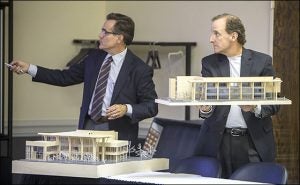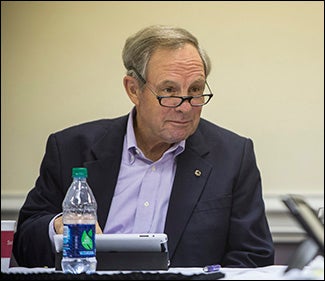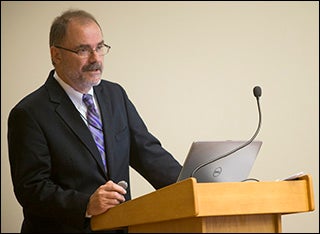‘FRONT DOOR TO CAMPUS’
The design team for East Carolina University’s new Student Union is going back to the drawing board following input from the Board of Trustees.
Perkins+Will architects presented a model to the Finance and Facilities committee during the board’s quarterly meeting Sept. 18-19.

Architects Jim Merriman, left, and Jeffrey Stebar present models of the proposed student center during the Sept. 18-19 meeting of the ECU Board of Trustees. (Photo by Cliff Hollis)
Trustees asked that the center, which will front approximately 300 feet on 10th Street, have a more defined presence since it will be so visible from the street. There is no physical entry planned on 10th Street; students will access the center from all other sides.
“We had talked about how this (building) would be one of those ‘front’ doors to campus,” said Trustees chairman Robert Brinkley. “It needs more enhancement.”
To try to invigorate the streetscape, some of interior spaces – such as dining seating areas – will be moved from the Sonic Plaza side to the street side. Revised plans for the first and second floors are expected at the November trustees meeting, said Dr. Virginia Hardy, vice chancellor for student affairs at ECU.
“We need to take pause,” said Bill Bagnell, associate vice chancellor for campus operations at ECU. “We want to make sure that we do it right the first time.”
Plans call for the student union to cover almost 209,000 square feet, and an adjacent parking deck, with construction costing $95.5 million. Furniture, fixtures, audiovisual and other equipment plus design costs and fees will total $122.2 million. The facility will provide a new home for the Ledonia Wright Cultural Center, a new LGBT center, student government and student group office space, multi-venue dining facilities, a new bookstore and a dividable ballroom as well as balconies, patios and an outside media screen.
“It will be a transformative building for this campus for decades and decades to come,” said Chancellor Steve Ballard in his remarks to the trustees during the full meeting.

ECU Board of Trustees member Bob Plybon listens to discussions at the ECU Board of Trustees meeting. (Photo by Cliff Hollis)
The project includes a 700-car parking deck in same area as the current parking lot west of Mendenhall Student Center. With a short delay in approved plans, officials expect the center to be completed by the 2018 fall semester. Construction will take 24 to 30 months.
“The discussions on design, the challenges with programming, those are things that exist with any project,” said trustee Terry Yeargan, finance and facilities committee chairman. “There is a tug and pull that goes on with any process.”
Mendenhall Student Center was completed in 1974 when East Carolina had 11,000 students. Since then, the student body has grown more than 145 percent and an extensive health sciences campus with more than 3,000 students has developed around the Brody School of Medicine.
An almost 72,000-square-foot student union also will be built on the health sciences campus between the East Carolina Heart Institute and Laupus Library. The UNC Board of Governors and the N.C. General Assembly approved plans for both buildings earlier this year.
On Friday, trustees approved final plans for a new $4 million dance building to be built one block west of the corner of 10th and Evans streets. The building’s 16,000 square feet is the minimum amount needed for dance program accreditation. It will include dance studios, a library, courtyard and parking. Bids will be taken in spring 2015 with an estimated completion in early 2016.
In other business, Ron Mitchelson, interim provost, presented to trustees on enrollment trends in undergraduate and graduate students.
While the undergraduate numbers are up this fall, graduate school enrollment is down slightly.
“The decline has been strongest in the master’s degree in education. This is part of a total market decline,” he said. “We believe this has to do with funding and a lot to do with the 10 percent bump for earning a master’s degree which was taken away (by the state for teachers), but it looks like it might be coming back.”
Mitchelson said that as other regions in the United States have seen declines in the number of high school graduates, the South has grown by 45,000 graduates. “We’re in a very competitive environment (for undergraduates),” he said.
The university enrolled 22,252 undergraduates, the largest number in university history, he said, citing census day snapshot data. The number of new freshmen enrolled – 4,226 – is the third largest in ECU history. Total ECU enrollment is 27,511, which is 624 more students than last year and the fourth largest in ECU history. In the graduate school, enrollment stands at 4,740, which is 162 less than last year.
“The rapid decline for graduate applicants from eastern North Carolina bothers us,” Mitchelson said. “The growth in out-of-state applications shows that we’re doing something right.”
He pointed to new online graduate degree programs in health informatics and computer science, as well as a doctorate of nursing practice. Mitchelson also shared about Google ads marketing for graduate programs and improvements to the graduate application process.
Board of Trustees member Deborah Davis, who is the chief operating officer at Medical College of Virginia, voiced concern about online for-profit universities. “All of these universities in a box” have stripped some of the market away from traditional universities, especially in health sciences programs, such as RN to BSN nursing programs.

ECU Interim Provost Ron Mitchelson presents enrollment details to the Board of Trustees. (Photo by Cliff Hollis)
Board members also heard of the university’s retention rate for first-year students. The rate is 81.2 percent for first-year students who entered ECU in Fall 2013. The average retention rate at ECU’s peer institutions is 77.4 percent, according to Mitchelson.
A recent survey of freshmen showed that 64 percent said ECU was their first choice, according to a report from Dr. Virginia Hardy to the University Affairs committee.
The Beginning College Student Engagement survey had a 94 percent completion rate with first-year ECU students. More than half of the students, 55 percent, reported that they were first-generation college students (neither parent or guardian graduated from a four-year institution). Also of note: 49 percent of freshmen reported having jobs in high school.
Hardy also updated trustees on housing for the semester. At the beginning of the semester, 133 students were in temporary housing (living with resident advisor or in converted lounge areas). That number has been reduced to 85, Hardy said. The university has again contracted with North Campus Crossing to provide housing for 42 students.
Davis noted that Gateway East and West will come online in Fall 2015, providing about 720 beds in addition to a private apartment complex on Reade Circle. She said the university is “at a crossroads” while this construction is underway.